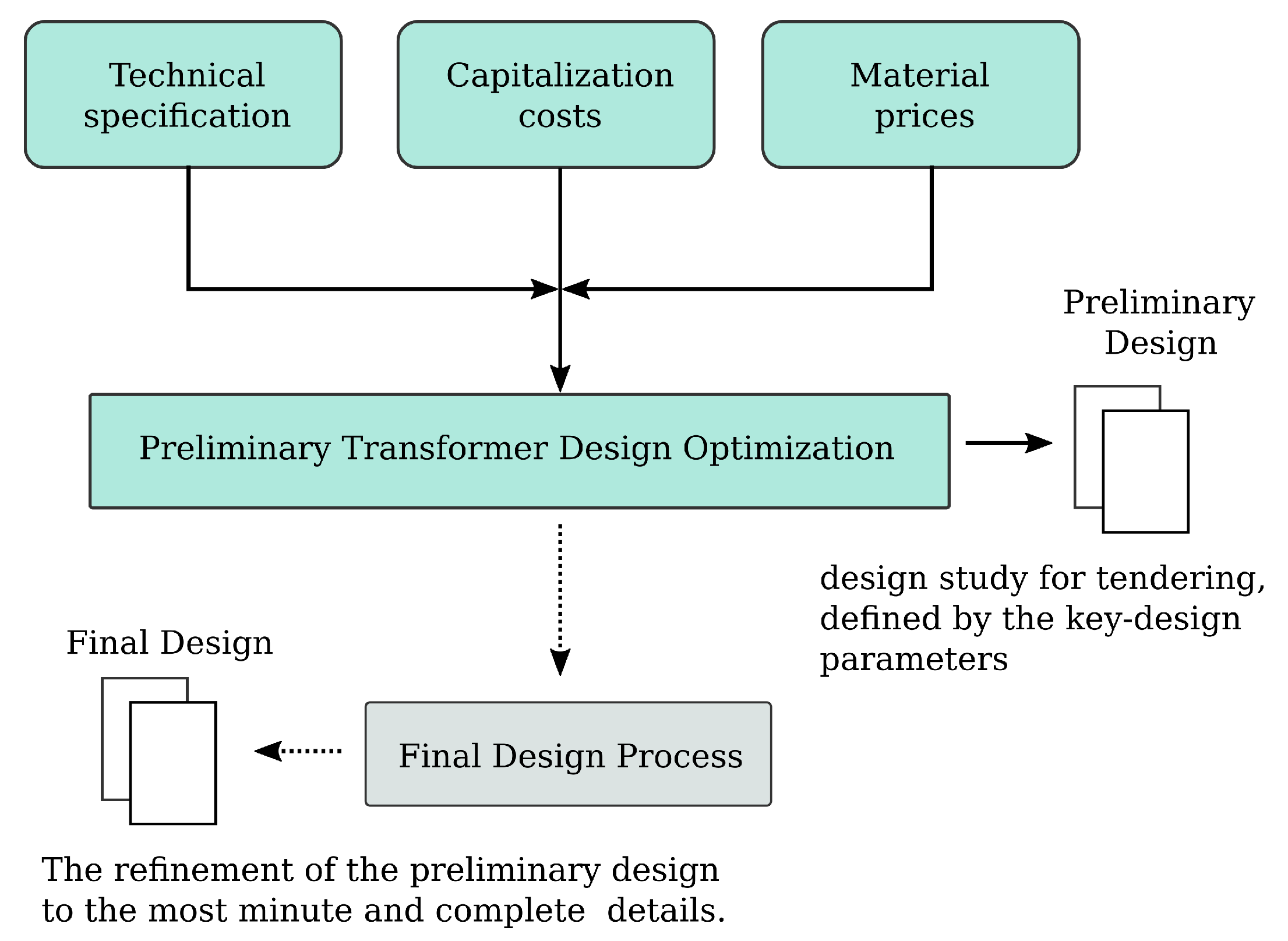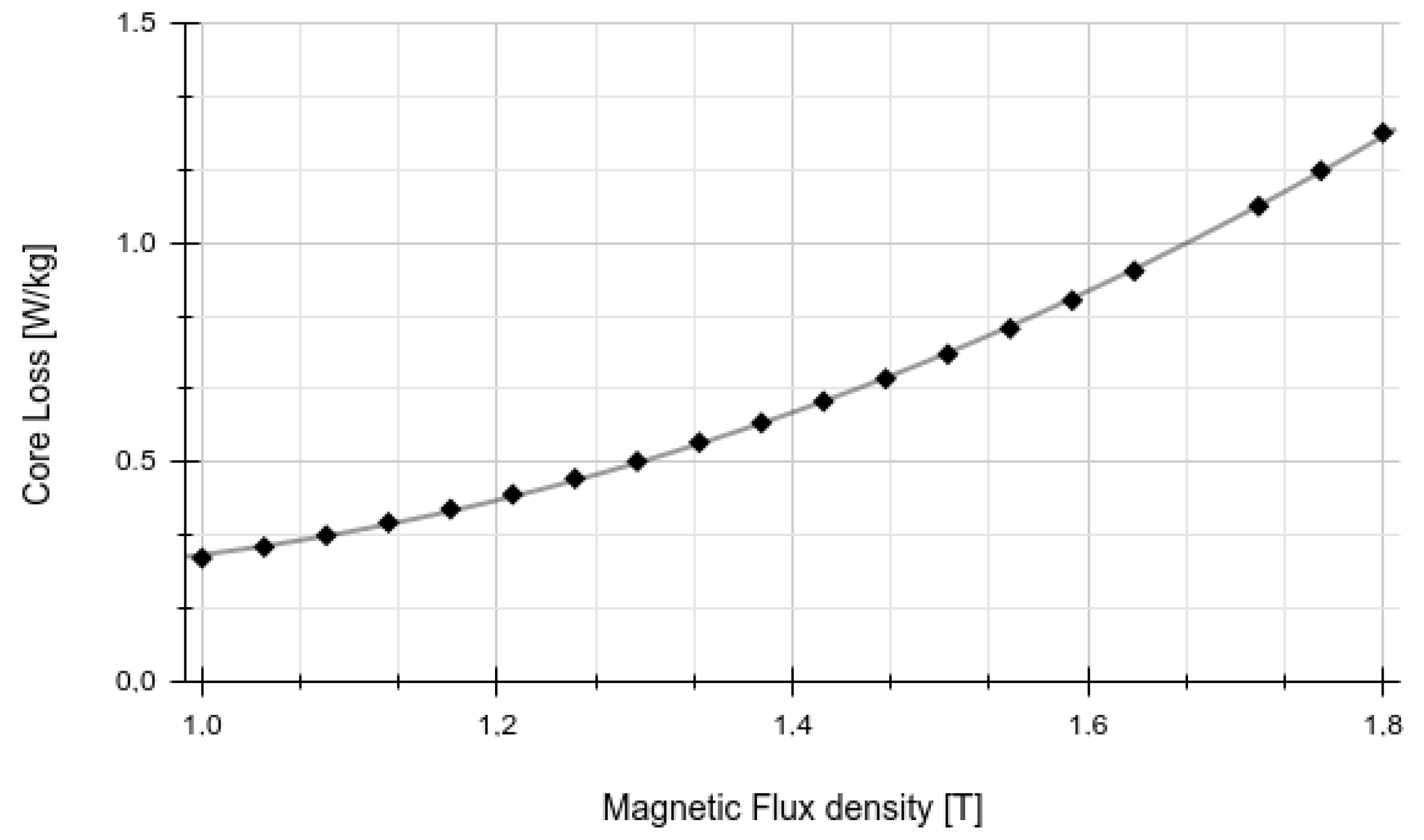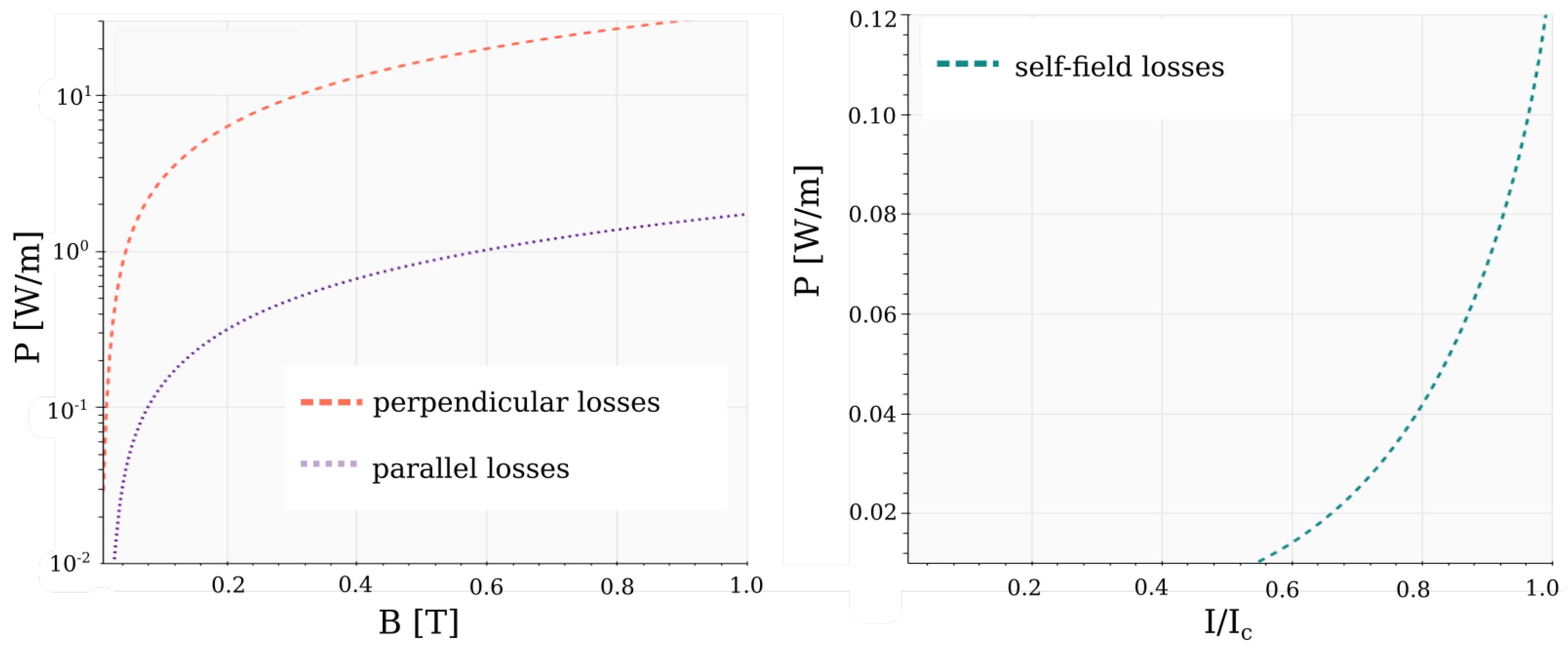FEM-Based Power Transformer Model for Superconducting and Conventional Power Transformer Optimization
Abstract
:1. Introduction
2. Materials and Methods
2.1. FEM-Based Two-Winding Transformer Model
2.2. Objective Function
2.3. Manufacturing Cost
2.4. Core Mass and No-Load Losses
2.5. Load Losses
Conventional Transformers
2.6. Load Loss Calculation in Superconducting Transformers
2.7. Calculation of the Short-Circuit Impedance and the Forces
3. Results
3.1. Modelling and Optimization of a Conventional Transformer
3.2. Optimization and TOC Calculations for Two Distinct Scenarios
3.3. Analysis of a Superconducting Transformer
4. Conclusions
Funding
Institutional Review Board Statement
Informed Consent Statement
Data Availability Statement
Conflicts of Interest
References
- European Comission. Power-Open Source 3D Graphics Engine. Available online: https://ec.europa.eu/info/energy-climate-change-environment/standards-tools-and-labels/products-labelling-rules-and-requirements/energy-label-and-ecodesign/energy-efficient-products/power-transformers_en#energy-savings (accessed on 29 May 2022).
- De Almeida, A.; Santos, B.; Martins, F. Energy-efficient distribution transformers in Europe: Impact of Ecodesign regulation. Energy Effic. 2016, 9, 401–424. [Google Scholar]
- Orosz, T. Evolution and modern approaches of the power transformer cost optimization methods. Period. Polytech. Electr. Eng. Comput. Sci. 2019, 63, 37–50. [Google Scholar]
- Amoiralis, E.I.; Tsili, M.A.; Kladas, A.G. Transformer design and optimization: A literature survey. IEEE Trans. Power Deliv. 2009, 24, 1999–2024. [Google Scholar]
- Mendes, H.F.; Coutinho, C.J.; Felix, L.M.; Martins de Matos, A.N.; Meireles, J.F.; Pinho, A.C.; Teixeira, J.R.S. Advanced Modeling and Experimental Validation of an Optimized Power Transformer Tank. In Proceedings of the ASME 2018, Pittsburgh, PA, USA, 9–15 November 2018; American Society of Mechanical Engineers: New York, NY, USA, 2018. [Google Scholar]
- Orosz, T.; Sleisz, Á.; Tamus, Z.Á. Metaheuristic optimization preliminary design process of core-form autotransformers. IEEE Trans. Magn. 2015, 52, 1–10. [Google Scholar]
- Orosz, T.; Sorés, P.; Raisz, D.; Tamus, Á.Z. Analysis of the green power transition on optimal power transformer designs. Period. Polytech. Electr. Eng. Comput. Sci. 2015, 59, 125–131. [Google Scholar]
- Kalsi, S.S. Applications of High Temperature Superconductors to Electric Power Equipment; John Wiley & Sons: Hoboken, NJ, USA, 2011. [Google Scholar]
- Staines, M.; Jiang, Z.; Glasson, N.; Buckley, R.; Pannu, M. Superconductors in the Power Grid: Materials and Applications; Robinson Research Institute, Victoria University of Wellington: Wellington, New Zealand, 2015; p. 367. [Google Scholar]
- Staines, M.; Pannu, M.; Glasson, N.; Allpress, N. Superconducting transformers–Part I. Transform. Mag. 2016, 3, 68–73. [Google Scholar]
- Moradnouri, A.; Ardeshiri, A.; Vakilian, M.; Hekmati, A.; Fardmanesh, M. Survey on high-temperature superconducting transformer windings design. J. Supercond. Nov. Magn. 2020, 33, 2581–2599. [Google Scholar]
- Irannezhad, F.; Heydari, H. Conducting a survey of research on high temperature superconducting transformers. IEEE Trans. Appl. Supercond. 2020, 30, 1–13. [Google Scholar]
- Xiao, L.; Lin, L. Recent progress of power application of superconductor in China. IEEE Trans. Appl. Supercond. 2007, 17, 2355–2360. [Google Scholar]
- Zueger, H. 630 kVA high temperature superconducting transformer. Cryogenics 1998, 38, 1169–1172. [Google Scholar]
- Staines, M.; Jiang, Z.; Glasson, N.; Buckley, R.; Pannu, M. High-temperature superconducting (HTS) transformers for power grid applications. In Superconductors in the Power Grid; Elsevier: Amsterdam, The Netherlands, 2015; pp. 367–397. [Google Scholar]
- Kubiczek, K.; Kampik, M.; Stepień, M. Characterization of high-temperature superconducting tapes. IEEE Trans. Instrum. Meas. 2019, 69, 2959–2965. [Google Scholar]
- Tomioka, A.; Otonari, T.; Ogata, T.; Iwakuma, M.; Okamoto, H.; Hayashi, H.; Iijima, Y.; Saito, T.; Gosho, Y.; Tanabe, K.; et al. The short-circuit test results of 6.9 kV/2.3 kV 400 kVA-class YBCO model transformer. Physica C Supercond. Appl. 2011, 471, 1374–1378. [Google Scholar]
- Wang, Y.; Zhao, X.; Han, J.; Dai, S.; Xiao, L.; Lin, L. Ac losses and mechanical stability in 630 kV A three-phase HTS transformer windings. Supercond. Sci. Technol. 2007, 20, 463. [Google Scholar]
- Qiu, Q.; Dai, S.; Wang, Z.; Ma, T.; Hu, L.; Zhu, Z.; Zhang, G. Winding design and electromagnetic analysis for a 1250-kVA HTS transformer. IEEE Trans. Appl. Supercond. 2014, 25, 1–7. [Google Scholar]
- Wang, Y.; Han, J.; Zhao, X.; Li, H.; Guan, Y.; Bao, Q.; Xiao, L.; Lin, L.; Zhu, Z.; Dai, S.; et al. Development of a 45 kVA single-phase model HTS transformer. IEEE Trans. Appl. Supercond. 2006, 16, 1477–1480. [Google Scholar]
- Staines, M.; Jiang, Z.; Glasson, N.; Buckley, R.; Pannu, M. Superconductors in the Power Grid; Woodhead Publishing: Sawston, UK, 2015. [Google Scholar]
- Pardo, E.; Staines, M.; Jiang, Z.; Glasson, N. AC loss modelling and measurement of superconducting transformers with coated-conductor Roebel-cable in low-voltage winding. Supercond. Sci. Technol. 2015, 28, 114008. [Google Scholar]
- Grilli, F.; Pardo, E.; Stenvall, A.; Nguyen, D.N.; Yuan, W.; Gömöry, F. Computation of losses in HTS under the action of varying magnetic fields and currents. IEEE Trans. Appl. Supercond. 2013, 24, 78–110. [Google Scholar]
- Magnusson, N.; Wolfbrandt, A. AC losses in high-temperature superconducting tapes exposed to longitudinal magnetic fields. Cryogenics 2001, 41, 721–724. [Google Scholar]
- Muller, P. Self-field hysteresis loss in periodically arranged superconducting strips. Physica C 1997, 293, 1. [Google Scholar]
- Tsukamoto, O.; Yamato, Y.; Nakamura, S.; Ogawa, J. Measurements of AC transport current losses in HTS tapes in an assembled conductor. IEEE Trans. Appl. Supercond. 2005, 15, 2895–2898. [Google Scholar]
- Baldwin, T.L.; Ykema, J.I.; Allen, C.L.; Langston, J.L. Design optimization of high-temperature superconducting power transformers. IEEE Trans. Appl. Supercond. 2003, 13, 2344–2347. [Google Scholar]
- Karsai, K.; Kerényi, D.; Kiss, L. Large Power Transformers; Elsevier: Amsterdam, The Netherlands, 1987. [Google Scholar]
- Del Vecchio, R.M.; Poulin, B.; Feghali, P.T.; Shah, D.M.; Ahuja, R. Transformer Design Principles: With Applications to Core-Form Power Transformers; CRC press: Boca Raton, FL, USA, 2017. [Google Scholar]
- Morandi, A.; Trevisani, L.; Ribani, P.; Fabbri, M.; Martini, L.; Bocchi, M. Superconducting transformers: Key design aspects for power applications. Proc. J. Phys. Conf. Ser. 2008, 97, 012318. [Google Scholar]
- Ghabeli, A.; Yazdani-Asrami, M.; Besmi, M.; Gholamian, S.A. Optimization of distributive ratios of apportioned winding configuration in HTS power transformers for hysteresis loss and leakage flux reduction. J. Supercond. Nov. Magn. 2015, 28, 3463–3479. [Google Scholar]
- Orosz, T.; Tamus, Z.Á. Non-linear Impact of the Short Circuit Impedance Selection on the Cost Optimized Power Transformer Design. Period. Polytech. Electr. Eng. Comput. Sci. 2020, 64, 221–228. [Google Scholar]
- Moradnouri, A.; Vakilian, M.; Hekmati, A.; Fardmanesh, M. HTS transformers leakage flux and short circuit force mitigation through optimal design of auxiliary windings. Cryogenics 2020, 110, 103148. [Google Scholar]
- Moradnouri, A.; Vakilian, M.; Hekmati, A.; Fardmanesh, M. Inductance Calculation of HTS Transformers with Multi-segment Windings Considering Insulation Constraints. J. Supercond. Nov. Magn. 2021, 34, 1329–1339. [Google Scholar]
- Berger, A.; Cherevatskiy, S.; Noe, M.; Leibfried, T. Comparison of the efficiency of superconducting and conventional transformers. Proc. J. Phys. Conf. Ser. 2010, 234, 032004. [Google Scholar]
- Staines, M.; Pardo, E.; Jolliffe, L.; Pannu, M.; Glasson, N. Prospects for HTS transformers in the grid: AC loss and economics. In Proceedings of the 12th European Conference on Applied Superconductivity, Lyon, France, 6–10 September 2015; pp. 6–10. [Google Scholar]
- Grant, P.M.; Sheahen, T.P. Cost projections for high temperature superconductors. arXiv 2002, arXiv:cond-mat/0202386. [Google Scholar]
- Malozemoff, A.; Verebelyi, D.; Fleshler, S.; Aized, D.; Yu, D. HTS Wire: Status and prospects. Phys. C Supercond. 2003, 386, 424–430. [Google Scholar]
- Scanlan, R.M.; Malozemoff, A.P.; Larbalestier, D.C. Superconducting materials for large scale applications. Proc. IEEE 2004, 92, 1639–1654. [Google Scholar]
- Orosz, T.; Pánek, D.; Karban, P. FEM based preliminary design optimization in case of large power transformers. Appl. Sci. 2020, 10, 1361. [Google Scholar] [CrossRef]
- Karban, P.; Pánek, D.; Orosz, T.; Petrášová, I.; Doležel, I. FEM based robust design optimization with Agros and Ārtap. Comput. Math. Appl. 2021, 81, 618–633. [Google Scholar] [CrossRef]
- Orosz, T.; Karban, P.; Pánek, D.; Doležel, I. FEM-based transformer design optimization technique with evolutionary algorithms and geometric programming. Int. J. Appl. Electromagn. Mech. 2020, 64, S41–S49. [Google Scholar] [CrossRef]
- 60076-20:2017; Power Transformers-Part 20: Energy Efficiency. IEC: Geneva, Switzerland, 2017.
- Georgilakis, P.S. Spotlight on Modern Transformer Design; Springer Science & Business Media: London, UK, 2009. [Google Scholar]
- Orosz, T.; Tamus, Z.Á. Impact of short-circuit impedance and tap changing method selection on the key-design parameters of core-form power transformers. Electr. Eng. 2018, 100, 1631–1637. [Google Scholar] [CrossRef]
- Green, M. The cost of coolers for cooling superconducting devices at temperatures at 4.2 K, 20 K, 40 K and 77 K. IOP Conf. Ser. Mater. Sci. Eng. 2015, 101, 012001. [Google Scholar] [CrossRef]
- Orosz, T.; Borbély, B.; Tamus, Z.Á. Performance comparison of multi design method and meta-heuristic methods for optimal preliminary design of core-form power transformers. Period. Polytech. Electr. Eng. Comput. Sci. 2017, 61, 69–76. [Google Scholar] [CrossRef]
- Kulkarni, S.V.; Khaparde, S. Transformer Engineering; Marcel Dekker: New York, NY, USA, 2004. [Google Scholar]
- Posco Progenmap Electrical Steel, Ltd. Typical Electrical Steel Properties. Available online: https://posco-poggen.com/product/grain-oriented-electrical-steel-grades/ (accessed on 26 June 2022).
- Wolfbrandt, A.; Magnusson, N. AC losses in high-temperature superconducting tapes exposed to perpendicular magnetic fields combined with transport currents. Supercond. Sci. Technol. 2002, 15, 572. [Google Scholar] [CrossRef]
- Norris, W. Calculation of hysteresis losses in hard superconductors carrying ac: Isolated conductors and edges of thin sheets. J. Phys. Appl. Phys. 1970, 3, 489. [Google Scholar] [CrossRef]
- Kalsi, S.S. High-Temperature Superconducting Transformers. Wiley Encycl. Electr. Electron. Eng. 1999, 1–25. [Google Scholar] [CrossRef]
- Glasson, N.; Staines, M.; Allpress, N.; Pannu, M.; Tanchon, J.; Pardo, E.; Badcock, R.; Buckley, R. Test results and conclusions from a 1 MVA superconducting transformer featuring 2G HTS Roebel cable. IEEE Trans. Appl. Supercond. 2016, 27, 1–5. [Google Scholar] [CrossRef]
- Andersen, O.W. Transformer leakage flux program based on the finite element method. IEEE Trans. Power Appar. Syst. 1973, PAS-92, 682–689. [Google Scholar] [CrossRef]
- Tamás, O. TrafoCalc-Python Library for Transformer Design and Optimization. 2022. Available online: https://github.com/tamasorosz/TrafoCalc (accessed on 28 May 2022).
- Schlesinger, R.; Biela, J. Comparison of analytical models of transformer leakage inductance: Accuracy versus computational effort. IEEE Trans. Power Electron. 2020, 36, 146–156. [Google Scholar] [CrossRef]
- Padhye, N.; Deb, K. Multi-objective optimisation and multi-criteria decision making in SLS using evolutionary approaches. Rapid Prototyp. J. 2011, 17, 458–478. [Google Scholar] [CrossRef]
- Deb, K.; Pratap, A.; Agarwal, S.; Meyarivan, T. A fast and elitist multiobjective genetic algorithm: NSGA-II. IEEE Trans. Evol. Comput. 2002, 6, 182–197. [Google Scholar] [CrossRef]
- Pánek, D.; Orosz, T.; Karban, P. Artap: Robust Design Optimization Framework for Engineering Applications. In Proceedings of the 2019 Third International Conference on Intelligent Computing in Data Sciences (ICDS), Marrakech, Morocco, 28–30 October 2019; pp. 1–6. [Google Scholar] [CrossRef] [Green Version]






| Year | Country | Transformer |
|---|---|---|
| 1997 | Switzerland | 630 kVA, three-phase, = 18.72 kV/0.42 kV |
| 1997 | Japan | 5 kVA, three-phase, = 6.6 kV/3.3 kV |
| 1998 | USA | 1 MVA, single-phase, = 13.8 kV/6.9 kV |
| 1999 | Korea | 100kVA, three-phase, = 440 V/220 V |
| 2001 | Germany | 1 MVA, single-phase, = 25 kV/1.4 kV |
| 2003 | Germany | 100 kV, single-phase, = 5.5 kV/1.1 kV |
| 2004 | Japan | 4 MVA, single-phase, = 25 kV/1.2 kV |
| 2005 | France | 41 kVA, single-phase, = 2.05 kV/0.41 kV |
| 2010 | New Zeeland | 1 MVA, three-phase, = 11 kV/0.4 kV |
| 2010 | Japan | 2 MVA, three-phase, = 66 kVA/6.9 kV |
| 2010 | Italy | 10kVA, single-phase, = 1 kV/230 V |
| 2013 | Japan | 2 MVA, three-phase, = 66 kV/6.9 kV |
| 2014 | Japan | 400 kVA, single-phase, = 6.9 kV/2.3 kV |
| 2016 | Russia | 330 kVA, single-phase, = 10 kV/231 V |
| 2017 | China | 330 kVA, single-phase, = 10 kV/231 V |
| 2019 | Switzerland | 577 kVA, single-phase, = 20 kV/1 kV |
| 2020 | China | 6.5 MVA, single-phase, = 25 kV/1.9 kV |
| Parameter | Dimension | Notation |
|---|---|---|
| Core diameter | mm | |
| Magnetic flux density | T | |
| Height of the low voltage winding | mm | |
| Current density in the low voltage winding | ||
| Current density in the high voltage winding | ||
| Main insulation distance | mm | g |
| Requirements | Notation | Dimension | Value |
|---|---|---|---|
| Nominal Power | S | MVA | 10 |
| Frequency | f | Hz | 50 |
| Short-circuit impedance | SCI | % | 7.5 |
| Core filling factor | % | 89.2 | |
| HV winding | |||
| Connection type | - | - | star |
| Line Voltage | kV | 33 | |
| Filling Factor | % | 60 | |
| LV winding | |||
| Connection type | - | - | star |
| Line Voltage | kV | 6.9 | |
| Filling Factor | % | 70 | |
| End insulation | EI | mm | 220 |
| Ratio of the LV/HV winding heights | - | 0.97 | |
| Core gap distance | mm | 20 | |
| Phase distance | pd | mm | 50 |
| Design Parameters | |||
| Core diameter | mm | 420 | |
| Flux density | T | 1.7 | |
| Current density in LV | 2.65 | ||
| Current density in HV | 2.57 | ||
| Height of the LV winding | mm | 1100 | |
| Main insulation distance Costs | g | mm | 50 |
| No-load loss cost | €/kW | 7100 | |
| Load loss cost (I) | €/kW | 1000 | |
| Load loss cost (II) | €/kW | 6000 | |
| LV winding material | €/kg | 10.0 | |
| HV winding material | €/kg | 9.5 | |
| Core material cost | €/kg | 3.5 |
| Parameter | Dimension | Manufactured | Scenario I | Scenario II |
|---|---|---|---|---|
| Core diameter | mm | 420 | 405 | 485 |
| Flux density | T | 1.7 | 1.56 | 1.57 |
| Current density in LV | 2.65 | 2.86 | 2.1 | |
| Current density in HV | 2.57 | 2.33 | 2 | |
| h_in | mm | 1100 | 1025 | 952 |
| m_gap | mm | 50 | 20 | 55 |
| Capitalization cost | ||||
| Scenario I | € | 161,503 | 147,893 | 167,987 |
| Scenario II | € | 407,403 | 419,588 | 347,037 |
| Core loss | kW | 8.2 | 5.5 | 8.9 |
| Load loss | kW | 49.18 | 54.34 | 35.81 |
| Requirements | Notation | Dimension | Value |
|---|---|---|---|
| Nominal Power | S | MVA | 1.250 |
| Frequency | f | Hz | 50 |
| Short-circuit impedance | SCI | % | 5.8 |
| Core filling factor | % | 92.0 | |
| HV winding | |||
| Connection type | - | - | star |
| Line Voltage | kV | 0.4 | |
| Filling Factor | % | 8.7 | |
| LV winding | |||
| Connection type | - | - | star |
| Line Voltage | kV | 10.5 | |
| Filling Factor | % | 11.6 | |
| End insulation | EI | mm | 481 |
| Ratio of the LV/HV winding heights | - | 1.04 | |
| Core gap distance | mm | 50 | |
| Phase distance | pd | mm | 30 |
| Design Parameters | |||
| Core diameter | mm | 310 | |
| Magnetic Flux density | T | 1.5 | |
| Current-density in LV winding | 44.92 | ||
| Current-density in HV winding | 53.45 | ||
| Height of the LV winding | mm | 342.5 | |
| Main insulation distance | g | mm | 34.5 |
Publisher’s Note: MDPI stays neutral with regard to jurisdictional claims in published maps and institutional affiliations. |
© 2022 by the author. Licensee MDPI, Basel, Switzerland. This article is an open access article distributed under the terms and conditions of the Creative Commons Attribution (CC BY) license (https://creativecommons.org/licenses/by/4.0/).
Share and Cite
Orosz, T. FEM-Based Power Transformer Model for Superconducting and Conventional Power Transformer Optimization. Energies 2022, 15, 6177. https://doi.org/10.3390/en15176177
Orosz T. FEM-Based Power Transformer Model for Superconducting and Conventional Power Transformer Optimization. Energies. 2022; 15(17):6177. https://doi.org/10.3390/en15176177
Chicago/Turabian StyleOrosz, Tamás. 2022. "FEM-Based Power Transformer Model for Superconducting and Conventional Power Transformer Optimization" Energies 15, no. 17: 6177. https://doi.org/10.3390/en15176177
APA StyleOrosz, T. (2022). FEM-Based Power Transformer Model for Superconducting and Conventional Power Transformer Optimization. Energies, 15(17), 6177. https://doi.org/10.3390/en15176177






